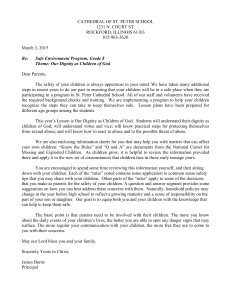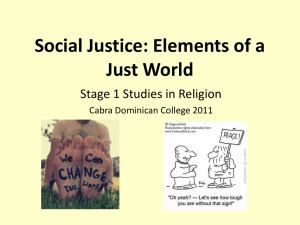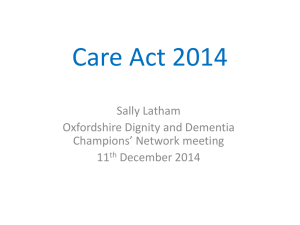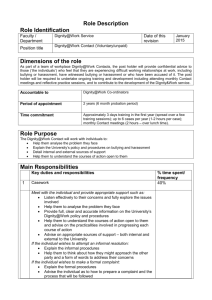DASA - Franklin-Essex
advertisement
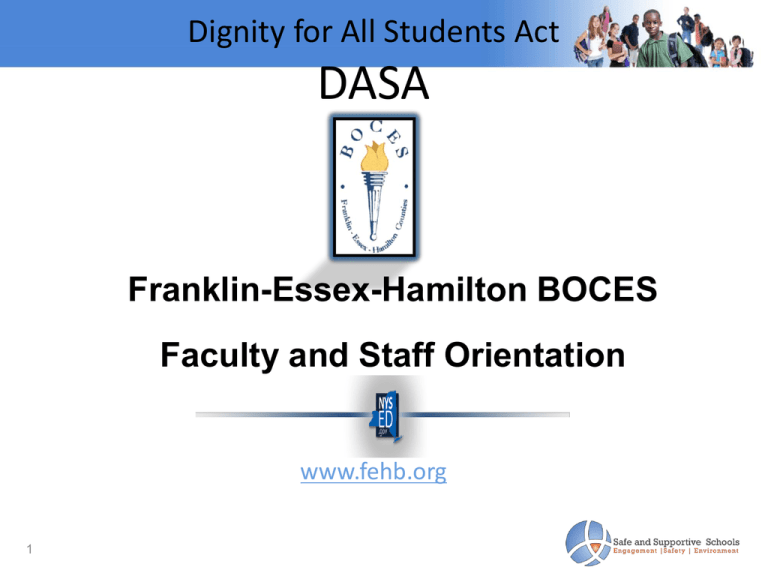
Dignity for All Students Act DASA BOCES Faculty and Franklin-Essex-Hamilton Staff Orientation BOCES Faculty and Staff September 3, Orientation 2014 www.fehb.org 1 Dignity For All Students Act New York State’s Dignity for All Students Act (The Dignity Act) seeks to provide the State’s public elementary and secondary school students with a safe and supportive environment free from discrimination, intimidation, taunting, harassment, and bullying on school property, a school bus and/or at a school function. 2 Dignity for All Students’ Act No student shall be subjected to harassment or bullying by employees or students on school property or at a school function; nor shall any student be subjected to discrimination based on a person's actual or perceived race, color, weight, national origin, ethnic group, religion, religious practice, disability, sexual orientation, gender (including gender identity or expression), or sex by school employees or students on school property or at a school function. 3 Legislative Intent: DASA The Dignity Act also amended Section 801-a of New York State Education Law regarding instruction in: 4 Civility Citizenship Character education Tolerance Respect for others Dignity Gender Non-Conforming Students The New York State Education Department (“NYSED”) is committed to providing all public school students, including transgender and gender nonconforming (“GNC”) students, with an environment free from discrimination and harassment, to fostering civility in public schools, and to ensuring that every student has equal access to educational programs and activities. The Dignity for All Students Act (“DASA”) illustrates the State’s commitment to ensuring that all students are educated in a safe and supportive school environment. http://www.p12.nysed.gov/dignityact/d ocuments/Transg_GNCGuidanceFIN AL.pdf 5 What to Look for in Bullying Behavior? Bullying is a form of youth violence that includes: 1. Unwanted, aggressive behavior. 2. A real or perceived imbalance of power between the person(s) doing the bullying and the person(s) being bullied. 3. Behavior that is repeated, or has the potential to be repeated, over time. Types of Bullying: 6 I. Social or Relational II. Physical III. Cyberbullying or Digital bullying IV. Verbal Personality Profiles Bystander: Many won’t aid victim Fear of becoming a victim Lowering of status Being branded a snitch Becoming aligned with the victim Bully: Is a behavior Seeks power Followers = More power 7 Personality Profiles Victim Low Peer Acceptance Vulnerable Perceived as different Will not defend themselves Up-stander: Someone who recognizes when something is wrong and acts to make it right. Speaks up Stands up for what is right Socially responsible 8 Students Most Likely to Be Bullied Some research suggests that students are most likely to be bullied because of perceived differences, such as: Appearance or body size Perceived to be gay, lesbian, bisexual, or transgender Degree of masculinity or femininity Performance in school Race/ethnicity/national origin and/or religion Low-income household Youth with disabilities and other special health needs 9 Citation 6 Possible Indicators of Students Who Bully Larger or stronger than classmates Enjoy controlling others Lack of empathy or compassion for others Feel more powerful than others Lack of emotion or remorse when discussing negative behaviors Enjoy conflicts and refuse to accept responsibility for negative behaviors Often have problems at school 10 Citation 6 Intervening in Bullying Behavior 1. Stop bullying on the spot. 2. Find out what happened. 3. Support the students involved. 11 Citation 13 De-Escalation Techniques Maintain Control of Your Emotions DO: Appear calm, centered, and self-assured; use a modulated low tone of voice. Be aware of options. Be respectful even when firmly setting limits or calling for help. If you feel you are losing control, call on a colleague, an administrator, security, or (in serious cases) your school resource officer or the police for support. DON’T: Be defensive even if the comments or insults are directed at you. Communicate Effectively Nonverbally DO: Allow extra physical space between you and the aggressor, get to the same eye level (kneel, sit, or stoop as needed), keep your hands out of your pockets to protect yourself, and stand at an angle to the student. DON’T: Turn your back, stand full front to the student, maintain constant eye contact, point or shake your finger, smile, or argue. De-escalate the Discussion DO: Trust your instincts, empathize with feelings but not with the behavior, suggest alternatives, and explain limits in a firm but respectful tone. DON’T: Get loud, yell, scream, argue, or analyze. 12 Responding to Reports of Bullying Respond Research Record Report Revisit Source: The New York State Dignity for All Student Act: Resource and Promising Practices Guide for School Administrators and Faculty (revised 2013) 13 http://fehb.org Reporting Form Reporting: 14 Franklin-Essex-Hamilton BOCES Dignity for All Students Act Coordinators Adirondack Educational Center Rick Swanston, Principal & Dignity for All Students’ Act Coordinator Contact: (518) 891-1330, rjs@mail.fehb.org North Franklin Educational Center Mary Jo Dickerson, Principal & Dignity for All Students’ Act Coordinator Contact: (518) 483-5230, mdickerson@mail.fehb.org 15 Resources http://www.netsmartz.org/StudentKit http://www.netsmartz.org/Parents http://www.stopbullying.gov/ http://www.cdc.gov/ http://fehb.org/DignityForAllStudents/guiding-principles.pdf http://www.p12.nysed.gov/dignityact/ 16 Contact: Michelle Law NYSED Dignity for All Students Act (DASA) Instructor Franklin-Essex-Hamilton BOCES Office of Instructional Support Services (518) 483-5430 or (518) 483-6420 mlaw@mail.fehb.org Office of Instructional 17
